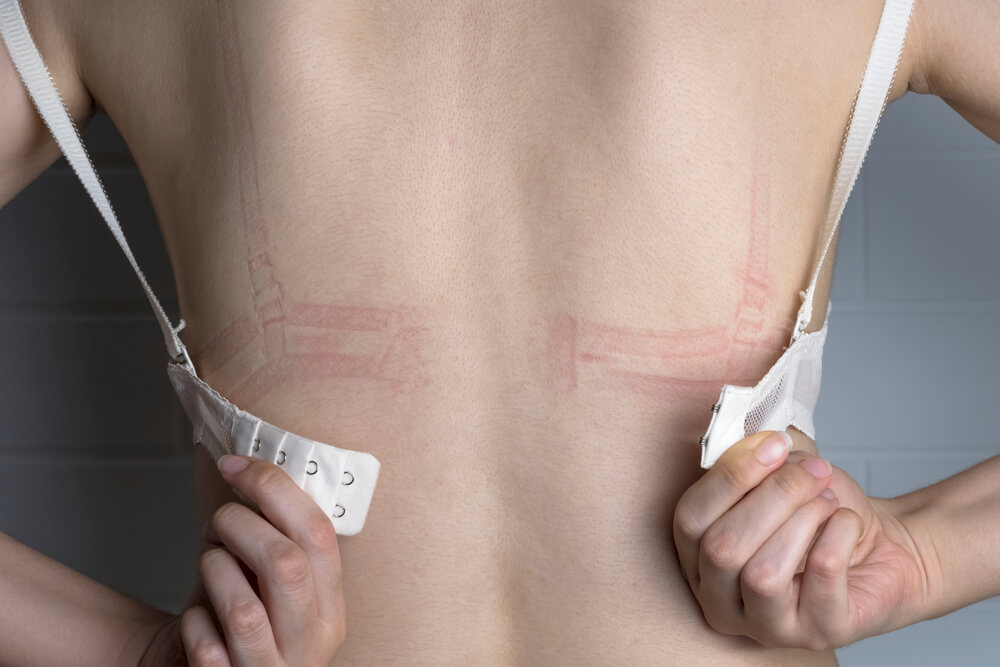Choosing the right bra size is not just about aesthetics; it plays a crucial role in maintaining women’s health and well-being. Yet, many of us find ourselves wearing bras that are too tight or ill-fitting, unknowingly subjecting our bodies to potential consequences. In this article, the experts from Breast Care Center Miami explore the often underestimated issues related to wearing the wrong bra size and shed light on the symptoms that may arise from donning a bra that is too tight.
The Impact of a Tight Bra: Unveiling the Hidden Dangers
Can a Bra Cause Chest Pain? Unraveling the Constriction
The quest for the perfect bra often involves balancing style with comfort, but what many women overlook is the potential for a tight bra to cause chest pain. The chest is a delicate region housing vital organs and a complex network of nerves and blood vessels. Wearing a bra that is too tight can inadvertently constrict this area, leading to discomfort and, in some cases, chest pain.
The constriction caused by an overly snug bra can compress nerves, restricting their ability to transmit signals properly. Additionally, blood vessels may face undue pressure, hindering the normal flow of blood to and from the chest. This compromised circulation can result in aching and soreness, symptoms that are mistakenly attributed to other factors in many cases.
It’s crucial for women to recognize that chest pain may not always be linked to cardiovascular issues or stress. A tight bra can be a hidden culprit, causing discomfort that affects the quality of daily life. By understanding this connection, individuals can take proactive steps towards finding a bra that not only complements their style but also prioritizes their physical well-being.
Tight Bra Side Effects: Beyond Mere Discomfort
The consequences of a tight bra extend far beyond the immediate discomfort one may feel. Prolonged wear of an ill-fitting bra can pave the way for a cascade of health issues, each more concerning than the last.
One of the primary concerns is restricted blood circulation. The bra acts as a constant pressure point on the skin and underlying tissues, potentially leading to compromised blood flow. This diminished circulation can manifest in various ways, from mild skin irritation to the development of persistent rashes. Over time, if left unaddressed, these seemingly minor issues can escalate into more serious conditions.
The skin, being the body’s largest organ, requires proper blood flow to maintain its health and integrity. Constricted blood vessels can hinder the delivery of essential nutrients, oxygen, and immune cells to the skin, setting the stage for chronic issues that extend beyond mere discomfort.
In extreme cases, prolonged wear of a tight bra may contribute to more serious conditions, including inflammation and damage to the breast tissue. This underscores the importance of not dismissing the side effects of a tight bra as temporary inconveniences. Regular self-checks and awareness of the signs of an ill-fitting bra can empower women to take charge of their breast health and make informed choices about their undergarments.
Symptoms of an Ill-Fitting Bra
Bra Too Tight: Identifying the Signs
Recognizing when a bra is too tight is cruial for preventing the associated health issues. Some common signs include red marks or indentations on the skin, straps digging into the shoulders, and the band leaving deep marks around the ribcage. These indicators should not be ignored, as they signal that the bra is not providing the necessary support and comfort. Regularly reassessing your bra fit and heeding these warning signs can empower you to proactively address issues before they escalate, ensuring both your immediate comfort and long-term breast health.
Physical and Emotional Impact
The consequences of an ill-fitting bra extend beyond the physical realm. Discomfort and pain can lead to emotional distress, affecting one’s confidence and overall well-being. It’s essential to prioritize both physical and emotional health when it comes to choosing the right bra.
Preventing and Alleviating Issues
Getting Professionally Fitted: A Tailored Approach to Comfort
One of the most crucial steps in ensuring you wear the right bra size is seeking the expertise of a professional bra fitter. Many women might shy away from this experience, underestimating the impact of changes in their body shape over time. Weight fluctuations, hormonal shifts, and even aging can all contribute to alterations in breast size and shape.
A professional fitting session is not just about finding a bra that fits; it’s about understanding the intricacies of your body and the dynamic nature of your bust. Certified fitters are adept at considering factors like the distribution of breast tissue, the shape of your ribcage, and even the nuances of various bra brands and styles. They provide personalized guidance, ensuring that the bra you choose not only fits correctly but also aligns with your unique body contours.
Regular fittings should be viewed as an essential part of your self-care routine. Just as you would visit a healthcare professional for regular check-ups, prioritizing your breast health by investing time in professional fittings can prevent potential health issues associated with wearing the wrong bra. It’s a proactive measure that empowers you with knowledge about your changing body and ensures you’re always providing the right support where it’s needed most.
Choosing the Right Style: Embracing Diversity in Design
Understanding that different styles of bras cater to varying breast shapes and sizes is key to finding the perfect fit. The world of lingerie offers a myriad of options, each designed to address specific needs and preferences.
When selecting a bra, it’s not just about the numerical size but also the style that complements your unique body. For instance, a balconette bra might be ideal for those with fuller breasts, offering lift and support, while a sports bra with encapsulation is perfect for high-impact activities.
Consider your lifestyle, daily activities, and personal comfort when exploring bra styles. A bra that provides adequate support without constricting is vital for long-term breast health. Remember, your body is unique, and embracing this diversity in design ensures that you not only look good but also feel comfortable and supported throughout your daily adventures.
Conclusion
In the quest for fashion and style, the importance of wearing the right bra size should never be underestimated. A tight bra can cause chest pain, lead to various side effects, and contribute to long-term health issues. By being aware of the symptoms of an ill-fitting bra and taking proactive measures to choose the right size and style, women can prioritize their health without compromising on comfort and style. Remember, a properly fitting bra is an investment in both physical and emotional well-being.






